Taarka Tarõ: A Seto restaurant
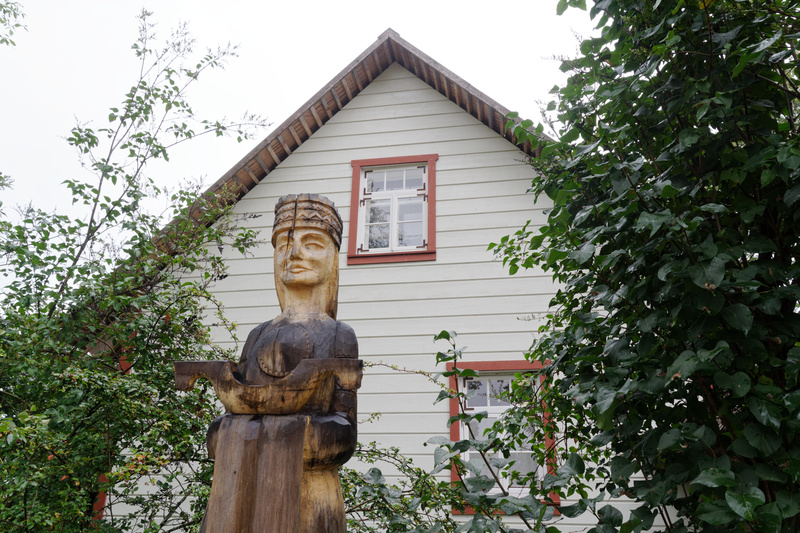
Statue outside the restaurant |
From the festival in Värska we drove on lonely forest roads to Obinitsa. The landscape here is mostly thick forest, with the occasional field here and there. At Obinitsa is a museum of Seto culture, and our main destination for the day, the Seto restaurant Taarka Tarõ, which is named after famous Seto singer Hilana Taarka.
The restaurant is in a lovely old wooden house. We take our shoes off in the entrance, and enter on creaking floorboards. The house feels like we're in someone's home, with homemade cloth rugs on the floor. The dining room is totally dominated by a huge oven. The Seto and the Estonians call these "ahi," and you'll be hearing much more about them later.

Inside the restaurant (oven on the left) |
In the dining room we're met by the family Horn. The restaurant is run by Rieka and Aare Horn, a Seto couple, I guess in their early 50s. Their son Semmo is also home for the summer, and luckily for us he speaks fluent English, which means we are in a position to learn much more than we did the day before. They make their own koduõlu, of course, which is why we are here.
The first thing they bring is the beer, which looks rather like what we had the day before: dark brown, hazy, very little head. The aroma is sooty earthy rye with fruity notes. It's dry, and a little bit acidic, probably from the rye, with very little carbonation. The finish has rye bread, pine needles, and again fruit. It's a really nice beer, full of flavour and character.
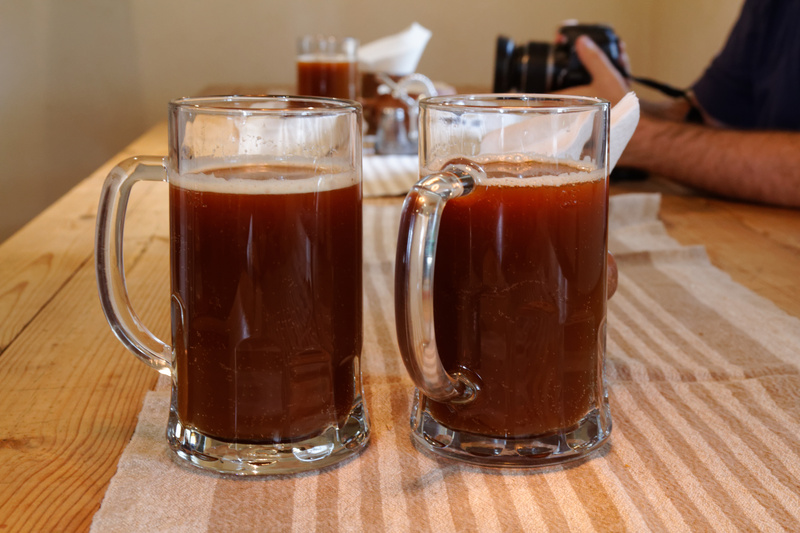
The beer |
Of course, we ask how it's made, and whether we can see the brewery. But it turns out that the beer is made in the kitchen. There's a reason for that. It turns out they brew from the same shop-bought rye malt "bread" that the people at the festival used, together with sugar, and Estonian bread yeast. That fruity flavour was probably from the bread yeast. There was no sign of any hop character in the beer, and they told us they never use hops in the beer.
They bring one of the "breads" so we can look at it. It's wrapped in plastic from the shop, but you can still smell the rye through the plastic. I break off a piece and taste it, and it's clear that the people at the festival were both right and wrong. No, it's not bitter, but it's true you can't eat it. It's far too dense and chewy, so dry and massive that you'd have to give up after a few bites. This isn't bread. It's made from rye malt flour, water, and rye flour, says the label. No yeast.
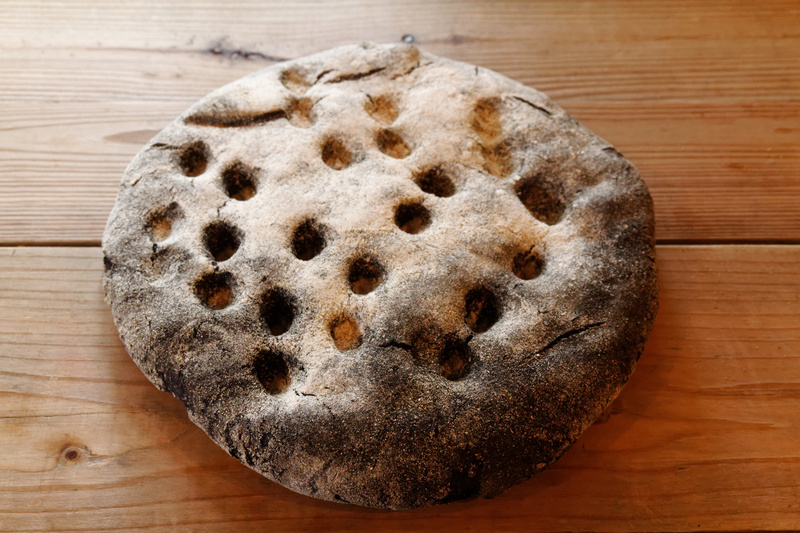
Rye malt "bread" |
The recipe says to pour 10 liters of boiling water on broken-up pieces of bread, add a kilo of sugar, cool, and then add yeast. So that explains why the Horn family are brewing it in the kitchen. It also explains the puzzled answers I got the day before when asking people if I could see their breweries. They all brew in the kitchen, because this brewing process is so simple you don't actually need much in the way of equipment.
From Aare we learn that in the old days people of course made the malts themselves, and baked the malts in a bread-like shape in the oven. They would heat the oven, take out the embers, then put the wet malts on a rhubarb leaf and leave it in the oven to bake. The bread was thicker than the one in the photo above, and would be black only on the outside. That sounds exactly like Lithuanian keptinis.
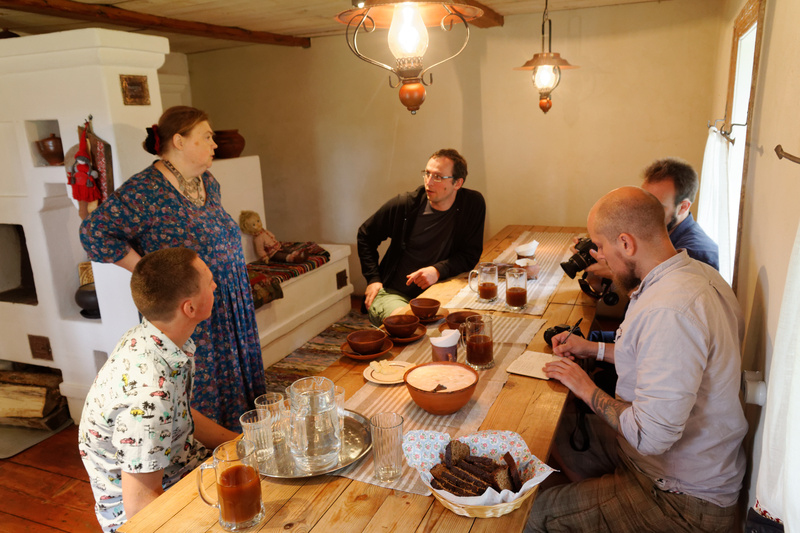
At the table. Semmo and Rieka on the left. |
When the beer was made the traditional way, there was no need for sugar, because there was enough enzymes in the malts. The bread would be broken up, hot water poured on, and the wort would run off. Then heated, poured back on top, and run through again. This would be repeated many times. And what was the filter? Straw and juniper. As I wrote earlier, juniper really has been surprisingly widely used. When we expressed surprise and delight at hearing people had been using juniper Aare went out to get another beer.
This one, he said, had been brewed with juniper. And sure enough, it had notes that were missing in the first beer: strong green damp forest and wet leaves flavours. It didn't taste specifically juniper, but the green foresty character was really vivid and clear, and in my opinion made this a much better beer than the first one.
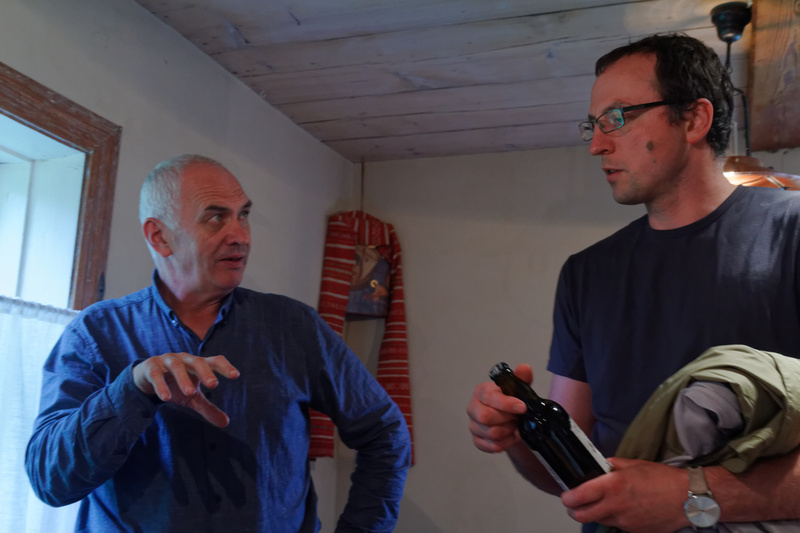
Aare talking with Martynas in Russian |
It seems that brewing here is quite common. Amund and I say we'd like to buy some malt loaves, to try brewing at home, and we're told that the shops have difficulty stocking enough. Aare kindly pops out to a nearby shop and gets four loaves for Amund (which he used to brew this beer) and one for me.
I ask Semmo whether he's learned to brew and he laughs, saying he learned when he was 7 or 8. A few years later, when he was 10, a friend of his came up with the idea of brewing beer and selling it in the break at the nearby theatre. His friend had the brewing gear, but didn't know how to use it, so he teamed up with Semmo. We both burst out laughing, imagining those two 10-year old boys selling beer at the theatre.
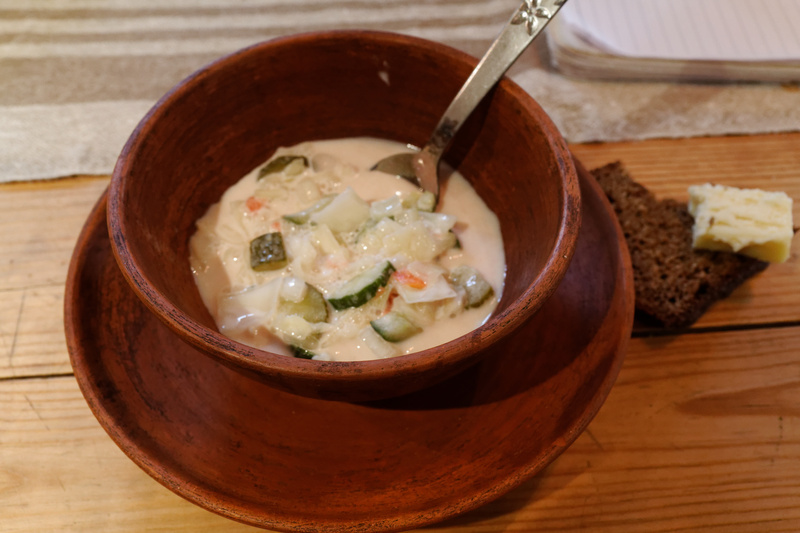
Sour cream soup, absolutely delicious |
I did brew a Seto koduõlu at home with the loaf I bought. It smelled so powerfully of rye through the plastic that I wrapped it in another plastic bag. Even so my suitcase reeked of rye for the rest of the trip. I mashed the loaf as described on the label for two hours by pouring boiling water on. The temperature was 82C after 2 minutes, 60C after an hour. The result was an OG of just 1.009, so you really do need the sugar. After adding a kilo of sugar I got 1.052.
I tried fermenting with kveik (using #11 Lida), but I had difficulties getting it to ferment. Probably the reason was that I added very little yeast, and kveik usually needs a lot of nutrient, which I didn't add, and the rye malt loaf might not have added very much, either. It came out quite nice, though, with a massively aromatic rye character from the malt loaf.
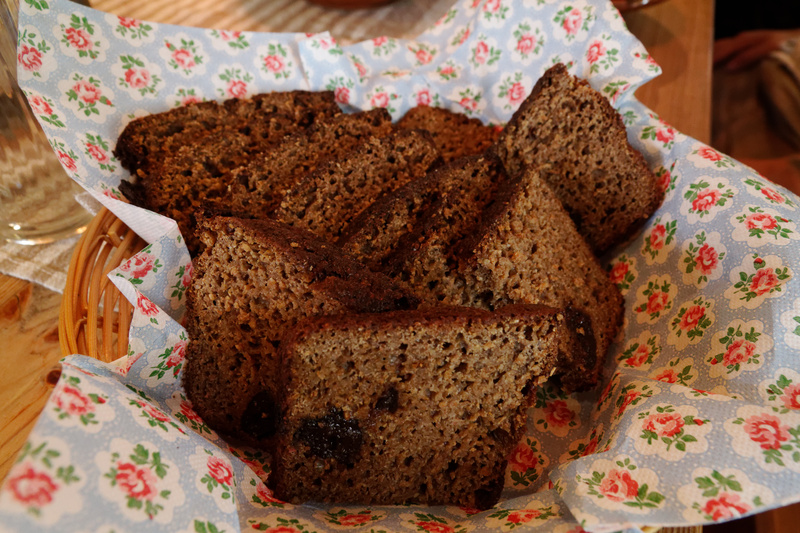
|
I measured the FG of the beer in Obinitsa with a refractometer and got 1.020, but be aware that this number is distorted by the alcohol. If I assume they had the same starting gravity as me this would really be an FG of 1.008 (makes sense, because it was dryish) and 5.9 ABV. That sounds about right.
So, in the end we did manage to figure out how this beer is made. As far as we could tell nobody makes the malts themselves any more. Planning the trip we'd looked longingly at the map, which showed Obinitsa is just 3-4km from the Russian border. Could there be farmhouse brewing in Russia, too? Aare told us that he'd met some Seto from Russia at the festival. They didn't sell beer, but they'd given him a bottle of beer. So, yes, clearly it does exist.
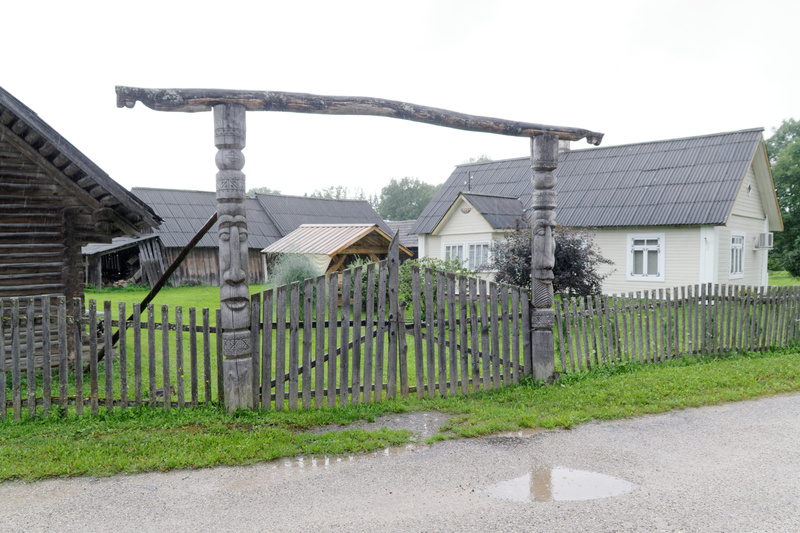
Totem pole gate in the rain |
Eventually, we had to take our leave, because we were going to visit more brewers. So now we had to drive across all of Estonia, to get to the Estonian islands in the Baltic.
Similar posts
Seto kingdom day
In south-eastern Estonia, and across the border in Russia, lives the Seto people
Read | 2017-11-05 10:36
Ramūnas Čižas, farmhouse brewer
Suddenly, we turn off the road, to stop next to a white-brick barn, decorated with beery graffiti text and drawings
Read | 2013-08-16 14:47
Comments
Mika Laitinen - 2017-11-15 19:37:27
I wonder if in the old days the conversion of starches to sugars happened already during the baking of the bread? From your comments I get the impression that in the bread you got starches had not been converted, but perhaps before table sugar the bread was made differently.
Lars Marius Garshol - 2017-11-15 20:45:02
My theory was exactly that, and I was thinking that people came up with this as an alternative to using hot stones for the mash. The driver, of course, being that they couldn't afford metal kettles. I concluded that if this was the case then there should be people, somewhere, who still do the entire mash in the oven. And, as you'll see later, there are people who do that, in both Lithuania and Russia, at least.
You're right that this "bread" has rather poor saccharification, but according to Aare in the old days, when people made the "bread" themselves they got enough sugar out of it. So I think it's just the modern "bread" that has poor conversion.